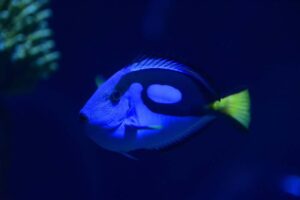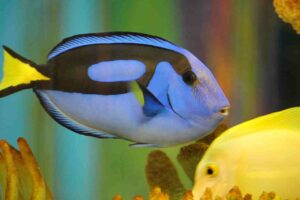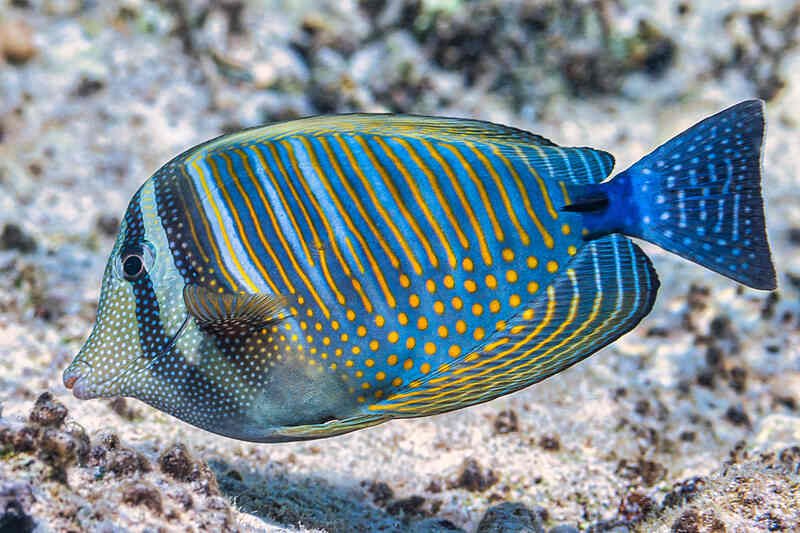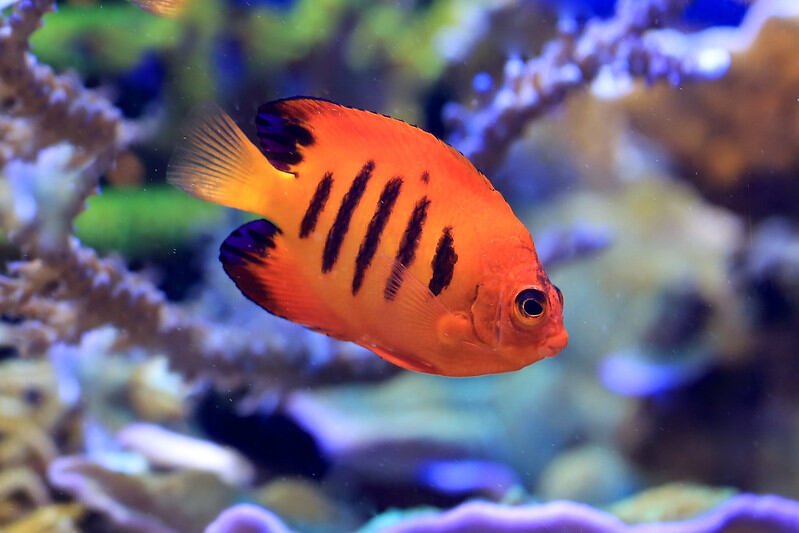As an aquarium enthusiast with a passion for Saltwater Fish, few species have captured my attention as much as the stunning Tang Fish (Acanthurus leucosternon). From its vivid coloration to its active nature, this fish brings life to any marine aquarium. Over the years, I’ve gained experience in caring for this beautiful yet demanding fish, and I’d like to share my insights on how to keep healthy and thriving in a saltwater environment.
Initial Fascination with Powder Blue Tang
The first time I saw a Tang Fish in a reef tank, I was mesmerized. Its vibrant blue body, contrasted with a bold black face and bright yellow dorsal fin, immediately caught my eye. The fish moved with grace and energy, darting between the coral structures as if it were in its natural habitat. I knew I had to include this species in My Aquarium collection Tips, but little did I know the challenges that would come with it.
Tang fish are known for being sensitive and somewhat difficult to keep, especially for beginners. Their beauty often tempts aquarium hobbyists, but their care requirements can be daunting. Having kept a variety of saltwater species, I felt confident that I could meet the needs of this particular fish. However, the experience quickly taught me that there were important lessons to be learned.

Setting Up the Tank: A Bigger Space for a Bigger Personality
Blue Tangs are highly active swimmers and need a lot of space to roam. When I first decided to introduce one into my tank, I made sure I had a large enough system. At least a 100-gallon tank is recommended, though bigger is always better. I started with a 120-gallon reef tank that provided plenty of open swimming space along with live rock for hiding and grazing.
Tangs are herbivores in the wild, constantly grazing on algae. That’s why it’s essential to have a well-established tank with ample live rock. My setup allowed the Tang Fish to naturally graze throughout the day, which not only kept it active but also helped with its dietary needs. However, I learned that providing a supplemental diet rich in marine algae, spirulina, and other plant-based foods was necessary to maintain its health. I also introduced nori (seaweed) sheets regularly, which the Tang eagerly devoured.
Handling Aggression: Managing a Territorial Fish
One thing I quickly noticed about the Powder Fish Tang is its territorial nature. These fish are known for being aggressive toward other Tangs, especially those of a similar shape or color. In my experience, introducing the Powder Blue last into a community of fish helped minimize territorial disputes. It’s always a good idea to carefully plan tank mates, avoiding other Tangs unless the tank is extremely large.
My Tang was introduced later than other species, but I have seen bullying behavior occasionally, especially toward smaller, more fearful fish. To mitigate this, I ensured there were plenty of hiding spots within the live rock and coral structures. This allowed less dominant fish to escape the Tang’s attention when needed. In time, the aggression subsided, and the Powder Blue became more comfortable with its tank mates.
Water Quality Precision and Consistency Are Key
One of the most critical aspects of keeping Powder Fish Tangs is maintaining pristine water conditions. These fish are sensitive to fluctuations in water quality, and poor conditions can quickly lead to stress, illness, and even death. I soon realized that consistent water changes and close monitoring of parameters like pH, nitrate, ammonia, and salinity were crucial to keeping the Tang healthy.
I invested in a high-quality protein skimmer and set up an automated water change system to ensure that I was always providing the best environment for my fish. Regular testing of water parameters became a part of my routine, and any sign of imbalance was addressed immediately. I also ensured the tank had strong water circulation, as Tangs thrive in well-oxygenated water with plenty of flow to mimic their natural environment.
Disease Prevention: Combating Ich and Other Parasites
One of the most common challenges with Tang Fish is their susceptibility to marine Ich (Cryptocaryon irritans), a parasitic infection that can quickly devastate a tank if left unchecked. When I first introduced my Tang, I took extra precautions to quarantine it for several weeks before adding it to the main display tank. During quarantine, I observed the fish closely for any signs of stress or illness and treated it with copper-based medications to prevent Ich from taking hold.
Despite these precautions, Tang Fish can still fall victim to disease, especially in stressful environments. That’s why maintaining excellent water quality and reducing stressors is essential. I also introduced a cleaner shrimp to my setup, which helped keep parasites at bay naturally by “cleaning” the Tang of any external parasites.
Feeding Challenges: Striking a Balance
Tang Fish have high energy demands and need a varied diet to thrive. Initially, I found it challenging to balance the right amount of food without overfeeding and causing water quality issues. Over time, I developed a feeding schedule that provided my Tang with small, frequent meals throughout the day.
In addition to the nori and algae-based foods, I occasionally offered frozen mysis shrimp and brine shrimp, which added variety and essential nutrients. The key, I discovered, was to avoid overfeeding and to ensure that the food was consumed quickly to prevent excess waste in the tank.
Social Behavior and Interaction: A Fish with Character
One of the most rewarding aspects of keeping a Tang Fish is observing its lively and inquisitive behavior. These fish are constantly on the move, exploring every corner of the tank and interacting with their surroundings. I often noticed my Tang “investigating” new additions to the tank, such as corals or invertebrates, and it even seemed to recognize me during feeding times.
Tangs, in general, are known for their intelligence, and the Powder Blue is no exception. I found that this fish quickly learned to associate my presence with food, and it would swim eagerly to the front of the tank when I approached. Over time, a bond formed, and I enjoyed the interaction and personality that this fish brought to my aquarium.
The Rewarding Challenge of Keeping a Powder Blue Tang
While the Tang Fish can be a challenging species to care for, the rewards far outweigh the difficulties. From its stunning appearance to its active and engaging behavior, this fish adds a dynamic presence to any saltwater Aquarium accessory. Through careful planning, attention to water quality, and a commitment to providing a suitable environment, I’ve successfully kept my Tang Fish healthy and thriving.
If you’re considering adding a Tang Fish to your saltwater tank, my advice is to prepare thoroughly, be patient, and understand the specific needs of this species. With the right care and attention, you’ll be rewarded with a truly captivating addition to your marine setup.
In the years that I’ve been keeping saltwater fish, the Tang Fish remains one of my favorites. It’s a fish that challenges you to be a better aquarist, and the satisfaction of seeing it flourish in your care is an experience unlike any other.
Aquarium Fish 5 Tips, 5 Problems, 5 Solutions
When I first decided to add a Tang Fish to my saltwater aquarium, I was drawn by its vibrant colors and unique beauty. But as with any aquarium fish, keeping a Tang Fish presents a set of challenges. Through my own experience, I’ve gathered valuable tips, encountered common problems, and discovered effective solutions. This is my trip and the lessons I discovered along the way.
5 Tips for Keeping a Powder Blue Tang in a Saltwater Aquarium
Provide Plenty of Swimming Space
One of the first things I realized when introducing a Tang Fish is that these fish need a lot of swimming room. A small tank won’t suffice; they thrive in a larger environment. For mine, I opted for a tank that was at least 100 gallons, and it made all the difference. The Tang Fish is highly active and loves to explore every inch of the tank.
Ensure Optimal Water Quality
Tang Fish are sensitive to water conditions. I learned early on that regular water testing is essential to keep parameters stable. I maintain the temperature between 72-78°F, pH levels around 8.1-8.4, and ensure salinity is steady. Investing in a good-quality filtration system and conducting weekly water changes kept my Tang healthy and vibrant.
Feed a Varied Diet
I found that my Tang Fish thrives on a mix of both herbivorous and carnivorous foods. While they primarily graze on algae, supplementing their diet with frozen mysis shrimp, seaweed, and marine flakes kept mine active and well-nourished. Introducing a balanced diet can enhance their immune system and maintain their bright coloration.
Minimize Stress
Stress can severely impact the health of a Tang Fish. In my tank, I created plenty of hiding spots using live rock and corals, allowing my Tang to retreat when needed. Avoiding overcrowding in the aquarium and limiting rapid changes in water parameters helped reduce stress levels.
Quarantine New Additions
One of the best decisions I made was to quarantine new fish before adding them to the main tank. Tang Fish are highly susceptible to diseases like ich. Quarantining helped prevent the introduction of any parasites or diseases that could affect my Tang and the entire tank ecosystem.
5 Common Problems When Keeping a Powder Blue Tang
Territorial Aggression
Blue Tangs can be territorial, especially when introduced into a tank with other Tangs or similarly shaped fish. I noticed mine becoming aggressive toward new tank mates. This aggression can escalate and cause stress to the other fish, leading to potential injuries.
Susceptibility to Disease
Tang Fish are prone to ich and other diseases, especially when stressed. I noticed white spots on my Tang after introducing a new coral without proper quarantine. The sudden outbreak threatened not only the Blue Tang fish but the rest of the tank’s inhabitants.
Feeding Difficulties
Initially, my Tang Fish was a picky eater. It refused the commercial foods I offered and only nibbled at the algae in the tank. This made it challenging to ensure it was getting all the nutrients it needed to stay healthy and maintain its vibrant colors.
Water Quality Sensitivity
Any fluctuation in water quality had a noticeable effect on my Tang. During a period of increased nitrates, I observed my Tang becoming lethargic and less active. Keeping water parameters stable was a constant challenge, especially in a busy reef tank environment.
Bullying from Other Fish
Even though my Powder Blue Tang was territorial, bigger or more powerful fish in the tank occasionally bullied him. I once had a particularly aggressive Angelfish that continually harassed my Tang, causing stress and even minor injuries.
5 Solutions to Overcome These Problems
Introduce Tangs with Care
To minimize territorial aggression, I introduced my Powder Blue Tang fish last, after the other fish had already established their territories. I also made sure the tank had enough hiding spots and rocks for the Tang to explore without feeling the need to fight for space. If aggression escalates, temporarily separating the aggressive fish or rearranging tank décor can reset territories.
Regular Health Monitoring
When it comes to illness, prevention is preferable to treatment. To combat ich, I invested in a UV sterilizer, which helped keep parasites in check. I also made sure to maintain stress-free conditions by avoiding overcrowding and performing frequent water changes. When I noticed early signs of ICH, I treated the tank with copper-based medications.
Offer a Variety of Foods
To overcome feeding difficulties, I experimented with different food types. By introducing a combination of algae-based foods and protein-rich options like brine shrimp, my Tang began eating more consistently. I also used feeding clips with seaweed, which helped mimic their natural grazing behavior.
Implement a Stable Water Management Routine
To maintain stable water quality, I set up a regular routine for testing water parameters. Adding a high-quality protein skimmer helped reduce nitrates and phosphates. I also invested in a reliable reverse osmosis (RO) system for water changes, ensuring I was using the purest water possible.
Create a Peaceful Community Tank
I was more selective about my tank mates after being bullied. I avoided overly aggressive fish and added more peaceful species like Gobies, Blennies, and Wrasses, which coexisted harmoniously with my Powder Blue Tang. If bullying did occur, I used an acclimation box to let the new fish adjust safely before full introduction.
Saltwater Aquarium Fish Guide
Factfile:
- Common Name: Blue Tang Fish (Surgeonfish)
- Scientific Name: Acanthurus leucosternon
- Size: Up to 23 cm (9 inches)
- Origin: Indian Ocean, from East Africa to Indonesia, including Bali in the Western Pacific.
- Tank Size: 400 liters (88 gallons) minimum.
Water Chemistry:
- Ammonia & Nitrite: 0 ppm
- pH: 8.1 – 8.4
- Nitrate: Below 25 ppm, ideally lower
Lifespan: Over 5 years, potentially living into double digits with proper care.
Sexing: Females may be larger than males, but noticeable differences only appear in large, mature fish.
The Tang Fish is an iconic and stunning addition to any saltwater aquarium. Though it is beautiful and widely available, it presents unique challenges, especially for aquarists who are not well-prepared. To ensure the long-term success of this fish in a home aquarium, it is crucial to create a system that caters to its specific needs.
Key Considerations:
- Susceptibility to Disease: Tang fish are highly prone to contracting Cryptocaryon (marine white spot) within the first few days of being introduced to a new tank. A UV sterilizer is a must to reduce the risk of parasites spreading.
- Specimen Selection: Always observe the fish’s feeding behavior before purchasing. Opt for specimens that are healthy, bold, and actively feeding. Avoid individuals that look undernourished (spine showing), as their recovery may be difficult.
- Territorial Nature: Blue Tangs Fish can be aggressive, especially toward other algae-eating species. Introducing them last into an established tank can help mitigate territorial issues.
How to Set Up a Powder Blue Tang Aquarium:
- Tank Size: A minimum of 400 liters (88 gallons) is necessary for the fish’s active swimming habits and to maintain water quality.
- Filtration: Use live rock for natural biological filtration. A protein skimmer is essential for maintaining water quality, and carbon dosing or bio-pellet reactors can help control nitrate levels.
- Water Flow: They thrive in areas with strong water currents, provided there are also calmer spots where they can retreat.
- UV Sterilizer: This equipment is essential for preventing parasites, especially during the first few weeks of introducing the fish to the tank.
- Aquascaping: Leave ample open space for swimming. Building a shallow reef slope at about 30 degrees allows them to move comfortably, mimicking their natural environment.
Tank Mates: Tang fish can cohabitate with a variety of species if introduced carefully. Small, active fish like Anthias, Damselfish, Fairy Wrasse, and Dottybacks generally mix well with minimal conflict. Larger species such as Dwarf Angelfish and Wrasses should be introduced first to establish their territories before adding the Tang Fish. However, avoid butterflyfish, as these often become targets of aggression from the Blue Tang.
Feeding: The Blue Tang Fish requires a varied diet that primarily includes algae. Dried seaweed like Nori should be available daily, and it can also be fed frozen foods like Mysis shrimp and Brine shrimp. Keeping their diet diverse and nutritious is key to their health and vibrant coloration.
Final Thoughts:
Powder Blue Tangs are a rewarding yet challenging species to keep. Success comes from thoughtful planning, research, and a well-designed system. With proper care, they can thrive for many years in a Saltwater Aquarium, bringing beauty and vitality to your marine environment.



